M5 crowd control munition
The M5 modular crowd control munition (MCCM) is a non-lethal direct fire device used to disperse, incapacitate and deny area access to large groups of people with percussion and flash (flash-bang) along with the impact from 600 high-velocity rubber or plastic balls moving outwards towards the crowd. It can be deployed and set up by troops (mounted or dismounted) and detonated via a command wire.[1]


It is similar in use and design to the M18A1 Claymore mine, but is non-lethal. Used for area denial, standoff situations, crowd control (i.e. outside embassies) by law enforcement and military services, the MCCM is effective to around 30 meters covering a 60–to-80 degree horizontal arc, with a minimum safe standoff distance of five meters from the face of the device.[2]
The MCCM is deployed in a minimum force role, where lethal outcomes may not be desired. It is a low hazard munition consisting of a 0.04" layer of sheet explosive (propellant). On one side of the sheet lies the projectiles (of .32 caliber, rubber or plastic PVC material) and on the other side, a foam sheet. These components are held together by an inert binder similar to plasticine.[2]
As described above, the MCCM is very similar to the M18A1 Claymore mine, except that the MCCM has a molded, tactile surface of raised diamonds on its back plastic cover which is a different color (light green), for easier discrimination between a lethal M18A1 Claymore and the non-lethal MCCM.[1]

It is currently in use by US military forces for area protection and defense. It can be vehicle mounted (for vehicle protection, and show-of-force crowd control), mounted to buildings and fencing, or used as a standalone device.
References
- M5 Modular Crowd Control Munition. Globalsecurity.org.
- M5 Modular Crowd Control Munition (MCCM). Pica.army.mil.